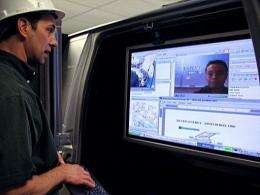US economic stimulus money fuels 'smart' power grid surge

Electric grids are getting smarter in an IBM lab in Texas as the promise of billions of US economic stimulus dollars fuels a drive to make power delivery more efficient and greener.
A chunk of stimulus cash aimed at promoting a "smart grid" designed to foster renewable energy generation and let people and utilities better manage electricity use has IBM in alliances with a growing host of startups.
"Smart grid was starting to get hotter, but post-stimulus it is dead center at IBM and in the venture community we deal with," said Drew Clark, director of strategy at IBM's venture capital group.
"What really got the juices flowing is that we see what is in the bill."
President Barack Obama's stimulus package devotes 10 billion dollars to smart energy technology, with nearly half of the money designated for power grid innovations, according to Clark.
A "proof-of-concept" lab at IBM's campus in Austin could almost double for a television studio set.
A mannequin lies in a bed in a mock hospital room equipped with sensors capable of detecting the presence of doctors, providing them details about patients, and even knowing whether medical personnel wash their hands.
Nearby are re-creations of a living room, kitchen, cafe, and utility control center, each featuring sensors that enable devices to anticipate the desires of those that enter.
Solutions Experience Lab IT architect Jeff Mausolf plays a utility control center worker reacting to a surge in demand due to a heat wave.
Mausolf taps a few computer keys, commanding a thermostat setting in a stage home to rise a few degrees, turning off power-gobbling air conditioning.
As the pseudo-emergency escalates, Mausolf turns off lights and appliances in houses by sending orders through "e-meters" to "smart outlets."
The technology is already being used in Austin.
Mausolf dons a white hard hat and walks to a utility repair crew van outfitted with computer gear that helps him swiftly diagnose outages and what is required to fix the problems.
"The biggest part of building all this was the security and encryption to protect the systems," Mausolf said, dismissing Hollywood film scenarios in which hackers commandeer power grids to wreak havoc.
"I don't worry about my power not being on in the morning when I wake up."
Even Internet search king Google has leapt into the energy management arena and called for investment in a nationwide smart grid.
Google announced in February that it is refining PowerMeter software that tells residents which devices in their homes are electricity hogs and which are being frugal with energy.
"There is a new excitement in the air about home energy management," Clark said. "The technology is coming. Google couldn't resist either."
The stimulus package sets out to push creation of an energy web mirroring interactive and user-empowering aspects of the Internet.
IBM is courting startups as well as championing a universal open technology standard to make certain that computerized appliances, meters, and other parts of a smart power web speak the same software language.
Clark sees the coming of in-home boxes similar to those provided by cable television firms, only these electronics-packed cases will be devoted to controlling electricity use.
It could evolve to a point where people choose whether their electricity comes from solar panels, wind turbines, coal plants, or nuclear facilities.
Tens of billions of dollars in the stimulus package are for new power lines, ideally in remote spots where winds or sun are prime for turbine or solar power generation.
"The cost of wind is at parity with coal and solar is damn close," Clark said. "The problem is delivering it."
IBM considers itself a "master architect" bringing together pieces of the power grid. The US technology giant recently won a contract to build an "intelligent infrastructure" in Malta for electricity and water.
"We are organizing IBM to take advantage of the urgency created around the infrastructure," Clark said. "We have been doing this for years, but the stimulus has set it on fire. We are locked and loaded; ready to go."
(c) 2009 AFP


















